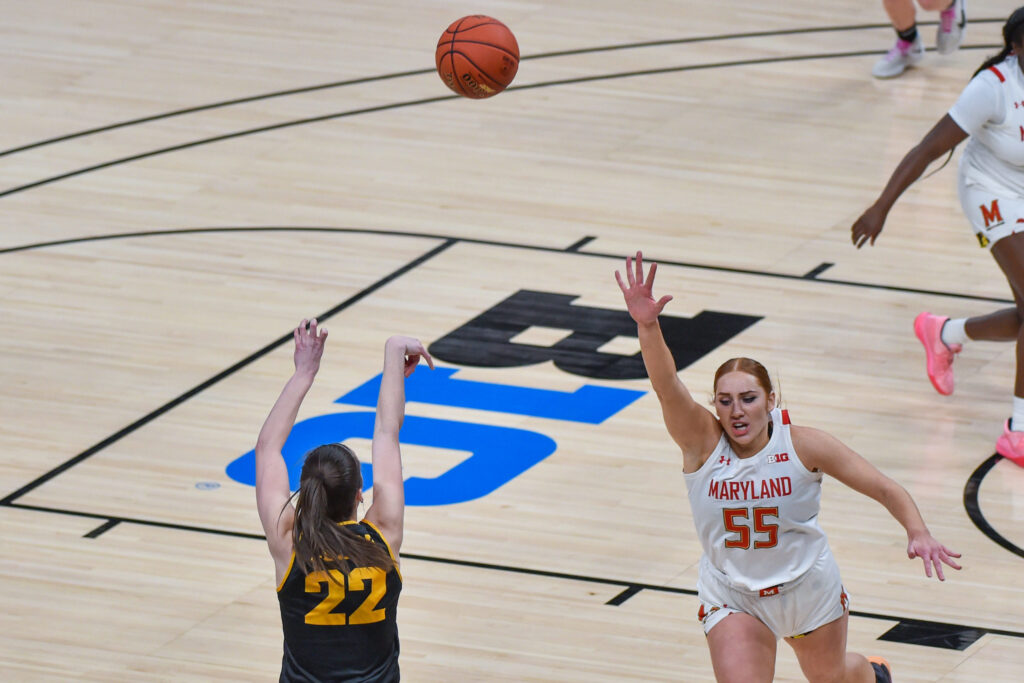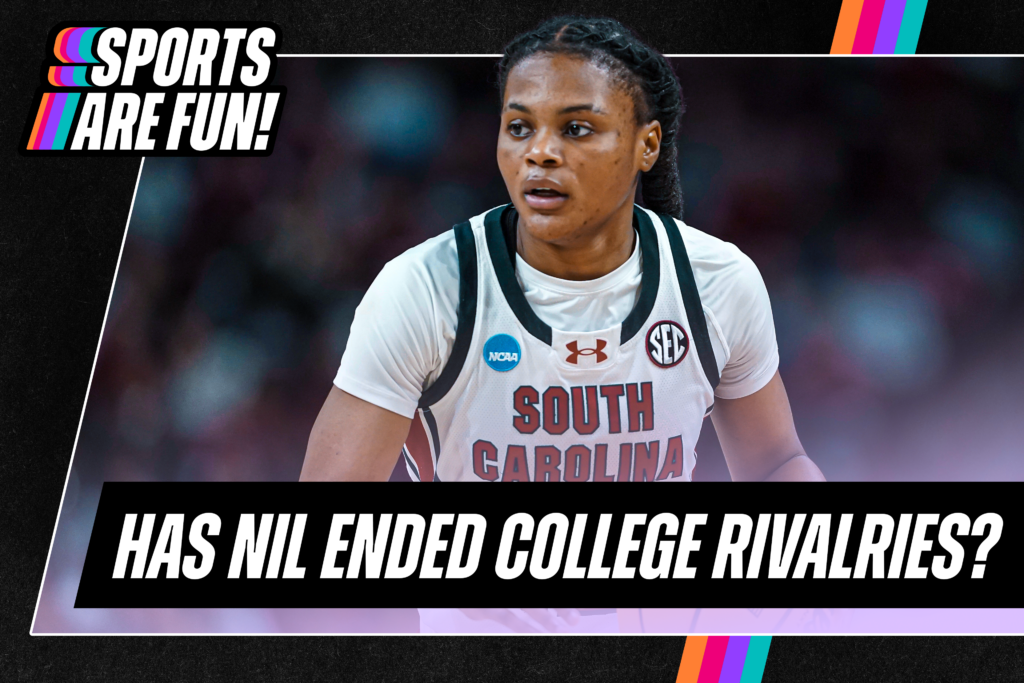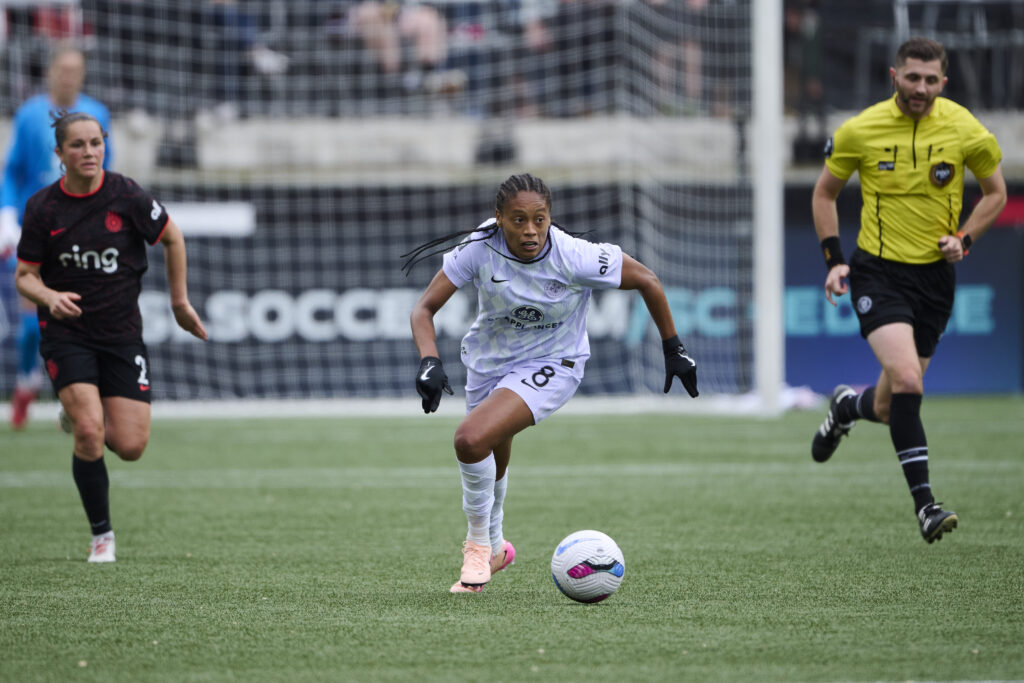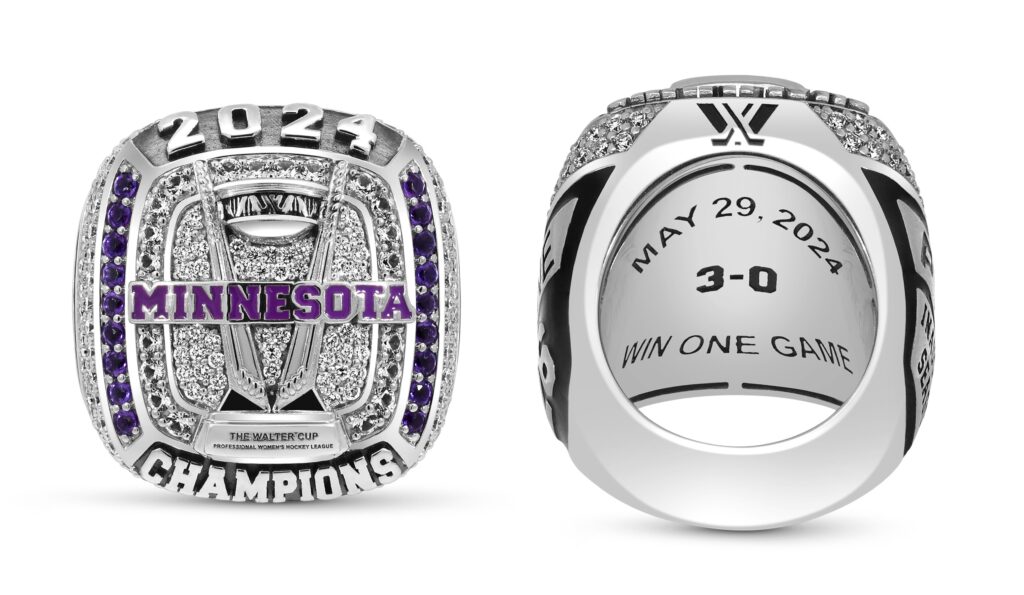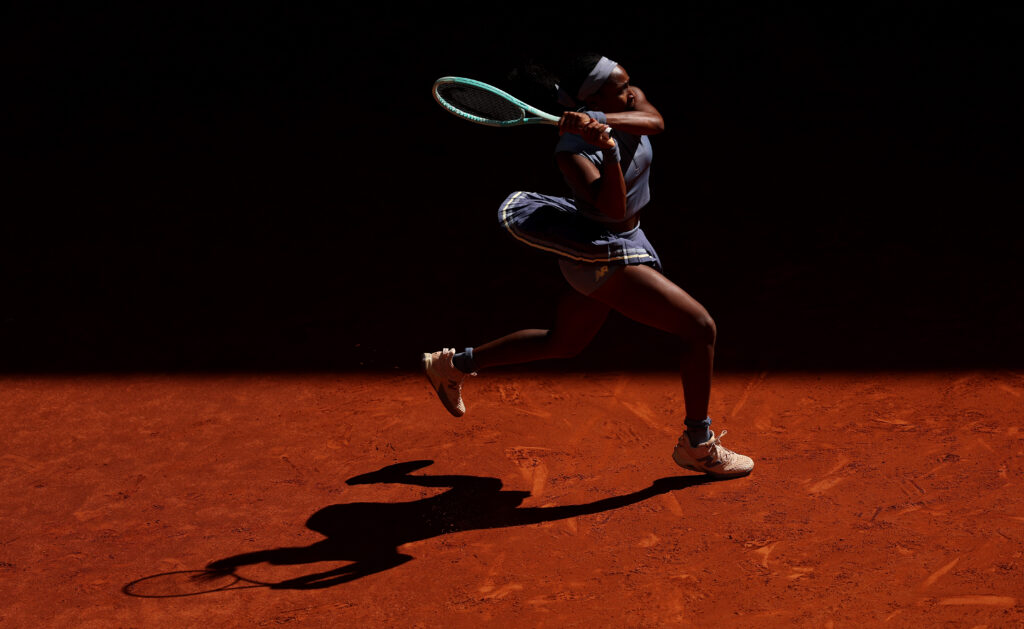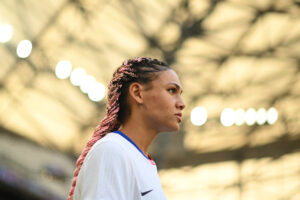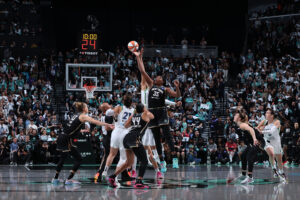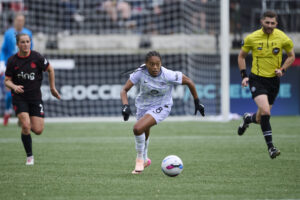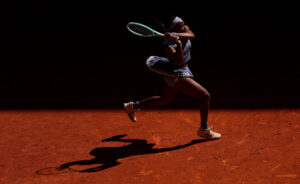At Big Ten Basketball’s combined media days in October, conference commissioner Kevin Warren announced the formation of a new position. The Vice President of Big Ten Women’s Basketball would be just the second role among the Power Five conferences to be focused solely on women’s basketball, showcasing the conference’s commitment to gender equity.
Last Thursday, the Big Ten filled the position with Megan Kahn, the former CEO and Executive Director of WeCOACH, an organization that supports the recruitment, advancement and retention of women coaches at all levels of sport. In a year when the inequities between men’s and women’s collegiate sports, and particularly basketball, have been pushed to the forefront, Khan is primed to lead the movement toward a level playing field.
Khan, who grew up in Iowa and has always been passionate about the Big Ten, will be tasked with “developing cohesive strategy to strengthen, enhance and expand the Big Ten women’s basketball operations, brand and strategic initiatives.” She’ll also serve as a liaison to head coaches, campus administrators and league’s television partners.
Just Women’s Sports spoke with Kahn about the new position, her plans for Big Ten women’s basketball and how she would like to see the conference continue to effect change at a national level.
What made you decide to leave WeCOACH and join the Big Ten?
I will tell you, I do love my job. I am so fortunate to never wake up in the morning and feel like I’m going to work. I’m just so passionate about what we do, serving coaches. Especially being able to do what we’re doing on a national level and impact so many women. I’ve passed on a lot of opportunities, but this one was just one that makes my heart sing. Having grown up in Iowa and in the Big Ten footprint, [I’m a] huge Big Ten fan. I have tons of friends and colleagues that are already in the league, and to go back to a women’s basketball-specific position at the best conference in the country is a complete no-brainer.
How do you think your experience at WeCOACH will help you as you step into your new role and attempt to take Big Ten Women’s Basketball to new heights?
My entire career journey has truly prepared me for this role. I’ve served in two conference offices, the ACC and the Atlantic 10 Conference. I’ve run two women’s Final Fours as the tournament manager, overseeing game operations, and then spent the last nine years here with WeCOACH, the last five as Executive Director and CEO.
I think that cumulative experience will help me be able to step in, come in with my own ideas, have an understanding of what it’s like to be in that position in a conference office and to really be able to elevate the brand.
For so long, [Big Ten women’s basketball] has probably not received the respect it’s deserved. Everything’s been SEC or the Pac-12, and both of those conferences have been extremely successful. But the strength of the Big Ten warrants them in that same conversation. The league’s probably as strong as it’s ever been, and that certainly was a drawing point for me when I was evaluating this position. When they first announced it, it was, “Oh my gosh, somebody gets to walk into a gold mine.”
You’ve mentioned that this job made your “heart sing.” What are you most excited about with this new role?
I get paid to eat, breathe and sleep Big Ten women’s basketball. How cool is that?
But for real, it’s everything that I love about college athletics and women’s basketball rolled into one job. So I get to come into a conference that’s already extremely successful, that has high standards for athletic excellence, academic excellence, which both align with my values. The product itself is fantastic. The coaches have done a phenomenal job recruiting talented student-athletes. They’re putting competitive teams on the floor every single night, so I have a great product to go sell. I get to talk and promote women’s basketball on a national level. I think the Big Ten has a chance to be a national thought leader and raise the bar and sort of set very high standards for what we’re seeing happen in the women’s game across the country.
And, I mean, this is unbelievable to walk into a position [where] you already have Commissioner Warren on board, right? How many times are women in our industry sort of fighting the leadership to get on board with what they’re trying to do in women’s sports? And you already have Commissioner Warren, who’s committed to walking the talk. So I’m walking into a position that has just tremendous upside.
What are your plans for growing Big Ten women’s basketball? Are there any specific strategies you’ve laid out so far?
My first official start date is Dec. 15. They’re going to be in the middle of their
conference season already. They’re less than 90 days from the women’s tournament in Indianapolis, so day one, I have to remind myself that this is a marathon, not a sprint.
In the first 30 to 45 days, my goal is to be on every single campus and meet the coaches and start really cultivating those genuine relationships. From my understanding, they haven’t had somebody that has their back every day, right? There’s been nobody in this position that they can call, that they can trust and that they know is out fighting for them and in their corner and has their back day in and day out. So that has to be priority No. 1, for me to go and start building those relationships.
And then, two, start building relationships with the internal and external stakeholders of the game — the media, your television partner, your corporate partners, your alumni, your fans. I think there’s so much that we can do in the digital space to really grow the brand, promote the brand, which in turn will help our coaches with recruiting. It will help the student-athletes with NIL opportunities and all of those things that come about from elevating your brand and really driving brand awareness in the national landscape.
Then there’s the footprint itself, with the conference spanning from Nebraska to the East Coast, you have an immense television package. I think there are 6 million alums at Big Ten institutions, so we have all the makings for success. It’s just sort of putting all those puzzle pieces in place and starting that build. We’ve got to start walking up the mountain one step at a time.
I said this in my Big Ten network interview: My goal by 2024 is that we’re selling out the semis and the championship game of the tournament. There’s no reason — Big Ten Women’s Basketball is that strong — that we shouldn’t be gunning for a massive turnaround. I think just from a data standpoint, those are some pretty big markers that we could hit within two-plus years.
This is just the second senior staff position among the Power Five conferences that is dedicated solely to women’s basketball. What do you think that says about the growth of the women’s game and about the change the Big Ten is trying to implement on a national scale?
It’s a testament to Commissioner Warren and his commitment to elevating women’s sports as a whole and women’s basketball, and his willingness to invest in the position and really let his coaches know how much he believes in giving them a platform to raise the bar and to elevate women’s basketball. And I do think we will see others follow. I always like to say imitation is the best form of flattery, so I have no doubt others will follow suit in terms of what the Big Ten is doing … we’re just primed to be national thought leaders and raise the bar and set some pretty high standards and let’s go make others chase us, right? The goal is that we would be in a position to be at the top of the echelon.

What was your reaction to disparities between the NCAA basketball tournaments last year? Was that part of the reason you wanted to get directly involved with the NCAA again, to push for real gender equity in college sports?
It was so heartbreaking for anyone who’s invested in the game of women’s basketball and women’s sports to watch that play out on the national scene last year. It was painful, and I am so glad to see the NCAA already making significant progress. I think if you asked the trailblazers who have been investing in and leading the game of women’s basketball for 20-plus years, they’ve been fighting these same battles. And yet it was continuing to say the same things over and over, but there was never progress being made. Not to their fault, it’s just there wasn’t buy-in, there wasn’t investment, there weren’t all the things in place that needed to happen for that progress to be made.
We’ve already seen significant progress with March Madness and the expansion of the bracket. … You take the fact that all that is happening in a very short amount of time, and these are the things that have been asked for for years, that’s progress. We still have a long way to go, but it’s encouraging to already see that much progress being made.
Expanding on that, what do you make of the NCAA’s response to the inequities and what else would you like to see change?
I do know that the NCAA’s working on a revamped strategic plan. I have no doubt that there’s going to be some trickle-down effects that will come down at the conference level, come down to the campus level, just really being able to elevate.
I think it’s going to be fantastic if they can unbundle some of those media rights that have had everything so tied up, that was limiting TV revenue, corporate sponsorship activation, some of those things that were really limiting what was happening on the women’s side. The two of those will absolutely create progress. I know they’re looking at a combined men’s and women’s Final Four as early as 2027. Next year, I think, is the first year they’ll go to two super regionals, but just so much growth and opportunity is happening on the national level, which is going to elevate all of women’s basketball across the country.
Talking about combining the tournament sites, do you think there would ever be a potential for that in the Big Ten?
I am not sure. I don’t know if that’s ever been talked about. I don’t know if that’s something that the coaches would even want … It’s a good question. I’ve asked myself that question, too.
Does it even make sense? How would you do the tournament format? Because each of their tournaments are, like, five days as it is, so how would the tournament bracket look? My hope is that, even if it would never be a combined tournament, we’re offering our men and our women student-athletes equitable experiences.
Beyond establishing your new role with the Big Ten, what positive steps have you seen the conference make toward gender equity and where do you see room for improvement?
I know Commissioner Warren has challenged each of their staff members to continue to come up with innovative and strategic ideas that can help elevate women’s sports across the whole. I know the leadership in the administration is looking at how they celebrate Title IX and give it the respect that it deserves in the 50th anniversary next spring. The fact that those conversations are playing out and the senior leadership team is committed to really implementing it and showcasing it and highlighting it and making it a priority that it gets done, I think is fantastic.
Let’s look at the combined media days that they had in Indianapolis in October. They’re one of the first to ever do that — input their men and their women coaches on the exact same stage, and their men and their women student-athletes got the exact same experience in the same building across two days. And the fact that BTN provided live coverage of all of that, that was innovative. And I know they pulled that off in a very short amount of time, and that shows Commissioner Warren’s commitment to really providing those equitable experiences.
What else do you have your eye on as you step into this role?
I think the one that comes out in the most public and visible way would be around the women’s tournament. Let’s make sure our women student-athletes at the women’s basketball tournament are having the exact same experience as our men’s basketball student athletes are getting in Chicago in 2022. That’s an immediate thing that I need to understand: What plans are in place for the ’22 tournament and where we can provide change and raise the bar?
The Big Ten has five teams in the AP Top 25, showcasing the conference’s strength and depth this year. How have you seen the Big Ten grow into a powerhouse and how do you plan to build on that success in your new role?
That’s the coaches. They’ve done a phenomenal job recruiting talented student-athletes, putting competitive teams on the court night in and night out. And they’re doing it as the best-kept secret in college basketball right now. They’re not getting the respect, I think, on the national level that they deserve.
The Women’s Basketball Committee, when we get to February and March and it’s time for Selection Monday, we need to do a great job of making sure that our teams have been seen, that I’m out there actively promoting and advocating for their selection, their ranking into the tournament. I think it was last year that they had seven teams make the postseason overall between the NCAA and the WNIT. Making sure that our teams get the recognition they deserve for postseason opportunities, that’s really important to me.
Emma Hruby is an associate editor at Just Women’s Sports. Follow her on Twitter @EHruby.
